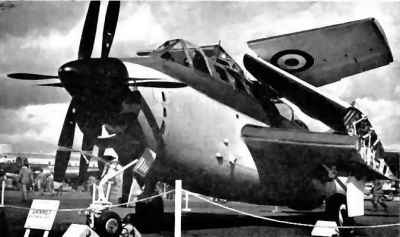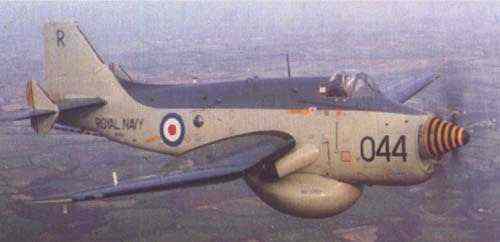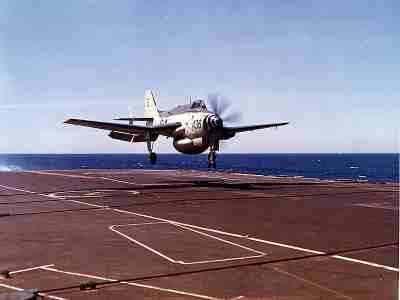Fairey Gannet AEW 3 |
Responding to a request of Royal Navy for an ASW aircraft,
Fairey
Aircraft began development of the Gannet, whose maiden flight was at Aldermaston on 19th september, 1949 and made the first deck landing by a
turboprop aircraft, on
HMS Illustrious (R87) on 19 June 1950 , by pilot Lieutenant Commander G. Callingham . It was designed to carry a crew of three, motorized with an unusual Armstrong-Siddeley Double Mamba coupled turboprop engine driving separate propellers, one of which could be stopped after liftoff to save fuel and extend range. The aircraft could be armed with torpedoes, depth charges and missiles, with a max speed of 299 mph and a range of 662 Nm.
The Gannet had tricycle landing gear, with twin-wheeled nose gear retracting backwards and single-wheel main gear retracting from the wings toward the fuselage. The aircraft had a stinger-type arresting hook. The Gannet's three crew sat in tandem, with pilot, observer-navigator, and radio-radar operator in their own cockpits, the radio-radar operator's seat facing the tail of the aircraft. The third prototype had differed from this configuration in placing both the "back seaters" in a single cockpit.
A total of 181 Gannet AS.1s were built. A "Gannet T.2" conversion trainer was also developed to help train pilots on dealing with the eccentricities of the Double Mamba relative to a piston engine, and to handle antisubmarine munitions. The T.2 featured a flight instructor in the middle cockpit with full backup flight controls and a periscope for forward view.
The designations of these aircraft updated to "Gannet AS.4", with initial flight in 1956, and "Gannet T.5", with initial flight in 1957. 75 AS.4s and 8 T.5s were built in all, and some existing AS.1s and T.2s were also updated to the improved standard.
The Gannet AEW.3 was powered by a Double Mamba Mk.102 with 3,875 horsepower. Initial flight was in August 1958. A total of 44 were built into 1961, by which time Fairey had been absorbed into Westland. The final Gannet AEW.3 was rolled out in December 1962, and was the last fixed-wing aircraft built by the company. Total Gannet production was 349 aircraft, including prototypes. It used the AN/APS 20 radar in a bulbous radome suspended beneath the body. This variant first flew in August 1958 , with trials carried out with HMS Centaur in November. For stability, it required a redesigned fin and rudder together with the small vertical fins on the tailplane fitted to the other versions.
ENGINE
After considering and discounting the Rolls-Royce Merlin (actually, twin Merlins) due to size, the Fairey decided to install an engine plant based on the Armstrong-Siddeley Mamba. An Armstrong-Siddeley Double Mamba (also commonly called the "Twin Mamba") was selected, driving two counter-rotating propeller through a common gearbox . The ASMD.1 engines (2,950hp) were used in the AS.1, ASMD.3 engines (3,145hp) inn the AS.4, and ASMD.4 (3,875hp) in the AEW.3 variant. The Double Mamba engine could be cruised with one of the engines stopped, to conserve fuel and extend endurance. It has been said by pilots that, while this was possible, it was inadvisable at low altitude -- in case the operating engine stopped for some reason. This happened frequently enough to be a 'known fault', and created considerable dis quiet for the crew while that or the other engine was restarted.
 This striking shot of the Fairey 17 Gannet shows well the double fold of the wings, which allows the overall height of the Gannet to remain the same whether the wings are spread or folded, the height of the tail remaining the governing factor. The third seat can be seen thru the fold of port wing
This striking shot of the Fairey 17 Gannet shows well the double fold of the wings, which allows the overall height of the Gannet to remain the same whether the wings are spread or folded, the height of the tail remaining the governing factor. The third seat can be seen thru the fold of port wing
 |
 |
Characteristics
Crew: 2
WIngspan:54' 4" (16.57 m)
Length: 43ft (13.11m)
Height:13' 9" (4.18 m)
Wing Area:490 sq.ft (45.5 m²)
Empty Weight: 14.069 lbs (6,395 kg)
Loaded Weight: 23,446 lbs (10,657 kg)
Powerplant: 1x Armstrong Siddeley Double Mamba ASMD.3, 3,145 hp (2,346 kW)
Max Speed: 299 mph (478 km/h)
Range: 662 NM (995 km)
Service ceiling: 25,000' (6,700 m)
Rate of climb: 310 ft/min (11.2 m/min)
Wing loading: 47.8 lbs/sq.ft (234 kg/m²)
Power/Mass: 0.13 HP/lb (0.22 kW/kg)
Armament:
Up to 2,850 lb (1,300 kg) of stores, including bombs
Depth Charges
2x torpedoes, carried internally
16x 60 lb (26 kg) rockets
|
|
|
|
|||||